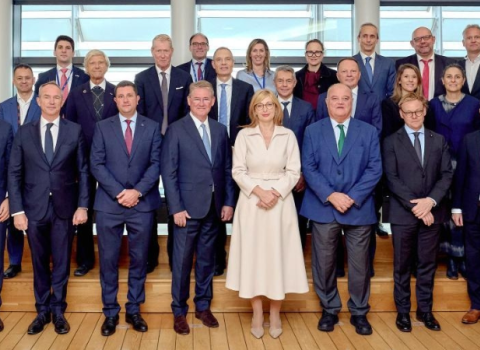
Martin Schuurmans, the chairman of EIT’s governing board, addresses the roundtable.
At a Science|Business Roundtable on the subject on May 26, when participants in the three Knowledge and Innovation Communities (KICs) launched in December were asked if they are happy with the way things are going, only three out of 10 said yes.
Not the most scientific of polls perhaps, but this snapshot reflects the difficulties these new communities are encountering as they move from being successful bidders to consortia that have to work together and find ways to turn their ideas into reality.
More images from the Roundtable
For more images of the event, visit the Science|Business photostream.
“We are being used as a kind of icebreaker by the European Union to try and find new territory,” Martin Schuurmans, the chairman of EIT’s governing board, said at the May 26 seminar.
As well as being experimental in nature, a key element of the KICs is entrepreneurship. Taken together, these two factors shed light on why some participants are finding this initial stage difficult: there isn’t any template to apply or set of rules to follow - the whole idea is to create something innovative.
Avoiding a ‘thou shalt do this’ approach
The KIC’s legal structure is one example of where the partners will have to come up with a solution that works for them. The EIT has not been explicit in what type of legal entity they should form. “It’s totally up to the KICs,” Schuurmans said.
The handling of intellectual property has also been left open. As Schuurmans noted, the EIT could have insisted that IP issues were sorted out at the beginning, but the risk would have been that ideas never got off the ground. The EIT also wanted to avoid a ‘thou shalt do this’ approach, he said.
Even on co-location, one of the central ideas of the KICs, it is up to the partners to decide exactly how to apply this principle.
Future timeline
As the three existing KICs get their structures and business plans in place, eyes are casting ahead to a further round of KICs. The consultation process will start immediately after the summer, followed by a series of conferences and with the EIT promising to come up with three or four new domains by around June 2011.
Healthcare is one field often mentioned, and one seminar participant suggested chronic diseases and/or lifestyle diseases as possible areas because of the crossover and the need to get education, government and companies involved.
The EIT has refrained from pre-empting the discussion that it is to take place over the next year.
What is crucial for Schuurmans, a former executive vice president at Philips Research/Philips Medical Systems, is to get things moving and to start seeing results. He wants a ‘can-do’ attitude to be fostered, not one that sees the free-form nature of KICs as an obstacle.
A new way of thinking
Almost six months on since the selection of the KICs, the euphoria of winning has past. Now the partners are knuckling down to the nitty-gritty: selecting a chief executive officer to steer the overall vision and ensure the integration of business, research and higher education, come up with a detailed business plan and become operational. A few wobbles are perhaps not surprising.
“The stakeholders are starting to have some concerns,” Bauer admitted. The KIC needs to be centrally organised in order to keep the consortium together, but inevitably this means that each co-location has to give up some autonomy to the centre. “This isn’t always easy,” Bauer said, citing budgetary control as one example.
The KICs call for a new way of thinking and working. “Most of us are thinking in conventional categories,” Bauer said. “We need sufficient time and pressure to turn the ship.”
Schuurmans’ response to the KIC partners is like that of a motivational coach, “We know you can do it. Figure it out yourself. It doesn’t need to be perfect, make it workable.”
The Climate-KIC has started to take initial steps, organising a summer school in Climate Change Innovation for 50 Masters and PhD students, who it terms “the pioneers”. Taking place between July 5 and August 13, participants will spend time in Paris, London and Zurich, joining researchers and business people as they seek to develop solutions to mitigate climate change and adapt to a changing climate.
Greet Vink of Delft University of Technology, one of the Climate-KIC’s partners involved in organising the summer school, said it would be a test bed that could lead to a more developed academic programme in Climate Change Innovation. “We need to first see what works and what doesn’t before we expand to a programme over several years,” Vink said.
Schuurmans acknowledged the different KICs will embark on their tasks in different ways. Responding to the plans of the Climate-KIC as outlined at the seminar, he said, “You’re now experimenting with the first steps. With the knowledge triangle, you will be working in one corner and then another, but at some point the CEO will have to step in and ensure that there’s integration.”
Business remains cautious
Corporate attitudes on whether or not to get involved in the KICs have varied. Reasons for staying away include a belief that the EIT’s 25 per cent contribution to the cost of the projects is not enough, needing a more concrete idea of the likely returns and awaiting an internal company strategy/policy on how to collaborate. Companies that have got involved see KICs as an opportunity to turn investments in EU Framework Programmes into results more quickly, or as a way to establish long-term associations with partners.
Schuurmans underlined the importance of companies staying on board. The share of businesses involved in all three KICs is “very, very significant”. Now, Schuurmans said, “We come to the acid test: can business live up to the commitments? I challenge you to do so because you will be handsomely rewarded. How you will be rewarded depends on your relationship with the KIC.”
The success of the KICs will be judged on their ability to create new businesses and encourage the education system to embrace entrepreneurship, Schuurmans said. Within three to four years, the EIT wants to see the “first clear business results”, be they new companies, new turnover or new university curricula. “Otherwise we have failed,” the EIT chairman said.
As a former marathon runner Schuurmans turned to the running metaphor to explain where the KICs are, and what is needed to succeed. “Today we are, at best, at the 10-kilometre mark. You feel a bit uncomfortable. You’re asking if this is going to be my day, or if you’re going to drop out. A successful marathon only comes after having run 30 kilometres. Have the stamina to sit it through.”
“This is a one-time event in Europe when you can change something [in a way] that has never been done before,” Schuurmans said at the close of the seminar.





 A unique international forum for public research organisations and companies to connect their external engagement with strategic interests around their R&D system.
A unique international forum for public research organisations and companies to connect their external engagement with strategic interests around their R&D system.